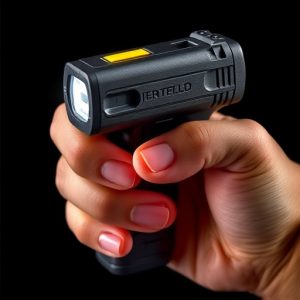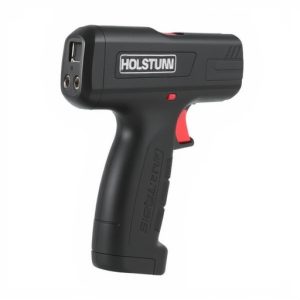Optimal Electrode Spacing for Stun Gun Effectiveness: A Comprehensive Guide
Stun guns (electronic control devices) temporarily disable attackers by delivering high-voltage, low…….
Stun guns (electronic control devices) temporarily disable attackers by delivering high-voltage, low-amperage electric current through precise electrode placement. Key factors influencing their effectiveness include optimal electrode spacing (1-2 inches or 2.5-5 cm), target size/shape, and environmental conditions. Understanding these variables ensures maximum power delivery and successful disruption of muscular control, making stun guns reliable tools for self-defense in emergency situations.
Stun guns, designed to incapacitate through electric shock, rely on strategic electrode spacing for their effectiveness. This article delves into the intricate world of stun gun technology, explaining how these devices function and emphasizing the significance of electrode arrangement. We explore factors influencing the performance of stun guns, offering insights into optimal practices for maximum impact. Understanding how does a stun gun work is key to appreciating the science behind its power, ensuring safe and effective use.
- The Basic Functioning of a Stun Gun
- Understanding Electrode Spacing in Stun Guns
- Factors Affecting the Effectiveness of Electrode Spacing
- Best Practices for Optimal Stun Gun Performance
The Basic Functioning of a Stun Gun
A stun gun, also known as an electronic control device (ECD), is designed to temporarily incapacitate a target through electrical impingement rather than physical force. Its basic functionality revolves around delivering high-voltage, low-amperage electric current to the body, disrupting muscular control and causing a powerful neuromuscular response. This reaction results in muscle spasms, disorientation, and temporary paralysis, enabling the user to escape or subdue an assailant.
The stun gun’s effectiveness lies in its ability to use strategic electrode placement and voltage output. Electrode spacing is crucial—closer spacing allows for more precise targeting of nerve centers, while wider spacing increases the shock area. This dual approach ensures that even if an attacker develops resistance to one type of shock, the stun gun’s versatility can still overcome their defenses. The device’s circuit board and power supply generate the electrical pulse, which is then channeled through metal probes or electrodes housed within the weapon’s tip. When deployed, this electric current disrupts the target’s nerve signals, leading to the desired effect.
Understanding Electrode Spacing in Stun Guns
Stun guns, also known as electronic control devices (ECDs), use electrical current to disrupt muscle control in an assailant, rendering them temporarily incapacitated. At the heart of this technology is electrode spacing—a critical factor that influences both the stun gun’s effectiveness and safety. Electrode spacing refers to the distance between the positive and negative electrodes within the device.
Proper electrode spacing ensures that a strong electrical field is generated, which is necessary for delivering a powerful shock. If the electrodes are too close together, the current may not spread effectively, leading to reduced stun performance. Conversely, excessive spacing can result in higher resistance, causing the stun gun to consume more power and potentially reducing its operational duration. Thus, understanding and optimizing electrode spacing is crucial for achieving optimal how does a stun gun work and maintaining user safety.
Factors Affecting the Effectiveness of Electrode Spacing
The effectiveness of a stun gun’s electrode spacing is influenced by several key factors, providing insights into how these devices operate. Firstly, the size and shape of the target play a significant role. Different body types and muscle mass can affect the electrical current’s distribution, leading to varying levels of immobilization. For instance, larger individuals might require closer electrode placement for optimal stun effectiveness.
Additionally, the environment and weather conditions can impact performance. Moisture on the skin or in the air can disrupt the stun gun’s functionality as it conducts electricity. Therefore, understanding these variables is essential when considering the overall success rate of a stun gun, especially when knowing how does a stun gun work lies in delivering an electric shock to disrupt muscular control and cause temporary incapacitation.
Best Practices for Optimal Stun Gun Performance
The optimal performance of a stun gun heavily relies on its electrode spacing, which is a crucial factor in delivering an effective shock. When a stun gun makes contact with the target, its electrodes transfer electricity through the skin to disrupt the body’s nervous system, causing muscle contractions and temporary incapacitation. The distance between these electrodes plays a significant role in the current flow and overall effectiveness.
For best results, maintaining proper electrode spacing is essential. Typically, this involves keeping the distance between the positive and negative electrodes within a recommended range, usually around 1-2 inches (2.5-5 cm). This ensures that the electric current flows smoothly and evenly across the contact point, maximizing its impact. Users should also ensure firm and direct contact with the target area, such as the thighs, arms, or back, to increase the likelihood of successful incapacitation. Understanding how a stun gun works and adhering to these best practices can greatly enhance its performance during emergency situations.
Stun guns, through their unique electrode spacing design, deliver powerful electrical currents that disrupt muscle control in an opponent. By understanding the factors influencing electrode spacing effectiveness, such as current strength and pulse width, users can ensure optimal performance when relying on these devices for self-defense. Following best practices outlined in this article, including maintaining proper maintenance and utilizing strategic targeting, will enhance the overall safety and efficiency of stun gun deployment. Remember, while stun guns offer a non-lethal alternative to firearms, their proper use is crucial for minimizing risks.


